Windows shellcoding - part 1. Simple example
﷽
Hello, cybersecurity enthusiasts and white hackers!
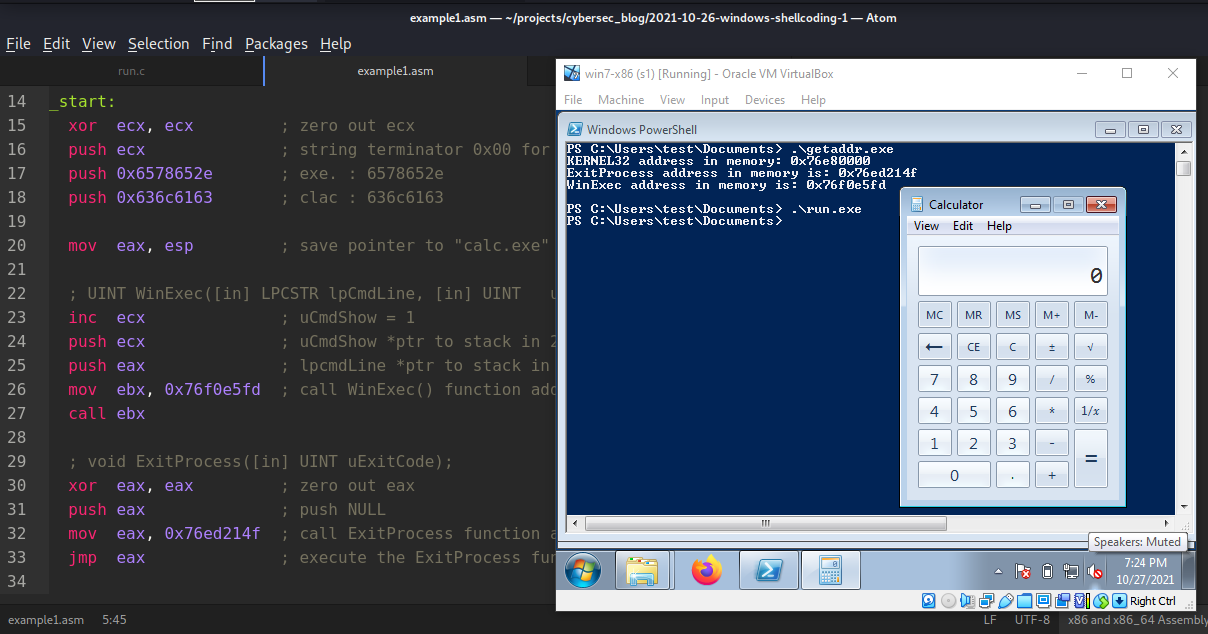
In the previous first and second posts about shellcoding, we worked with linux examples. Today my goal will be to write shellcode for windows machine.
testing shellcode
When testing shellcode, it is nice to just plop it into a program and let it run. We will use the same code as in the first post (run.c):
/*
run.c - a small skeleton program to run shellcode
*/
// bytecode here
char code[] = "my shellcode here";
int main(int argc, char **argv) {
int (*func)(); // function pointer
func = (int (*)()) code; // func points to our shellcode
(int)(*func)(); // execute a function code[]
// if our program returned 0 instead of 1,
// so our shellcode worked
return 1;
}
first example. run calc.exe
First, we will write something like a prototype of the shellcode in C. For simplicity, let’s write the following source code (exit.c):
/*
exit.c - run calc.exe and exit
*/
#include <windows.h>
int main(void) {
WinExec("calc.exe", 0);
ExitProcess(0);
}
As you can see, the logic of this program is simple: launch the calculator (calc.exe) and exit. Let’s make sure our code actually works. Compile:
i686-w64-mingw32-gcc -o exit.exe exit.c -mconsole -lkernel32

Then run in windows machine (Windows 7 x86 SP1):
.\exit.exe
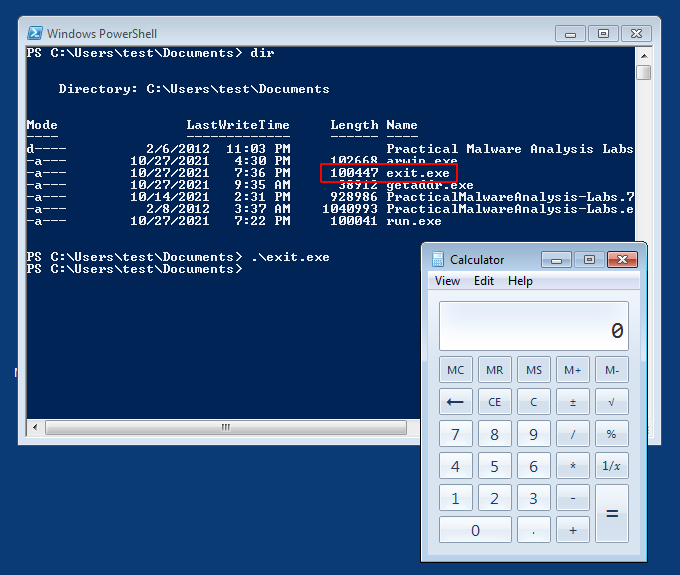
So everything is worked perfectly.
Let’s now try to write this logic in assembly language. The Windows kernel is completely different from the Linux kernel. At the very beginning of our program, we have #include <windows.h>, which in turn means that the windows library will be included in the code and this will dynamically link dependencies by default. However, we cannot do the same with ASM. In the case of ASM, we need to find the location of the WinExec function, load the arguments onto the stack, and call the register that has a pointer to the function. Likewise for the ExitProcess function. It is important to know that most windows functions are available from three main libraries: ntdll.dll, Kernel32.DLL and KernelBase.dll. If you run our example in a debugger (x32dbg in my case), you can make sure of this:
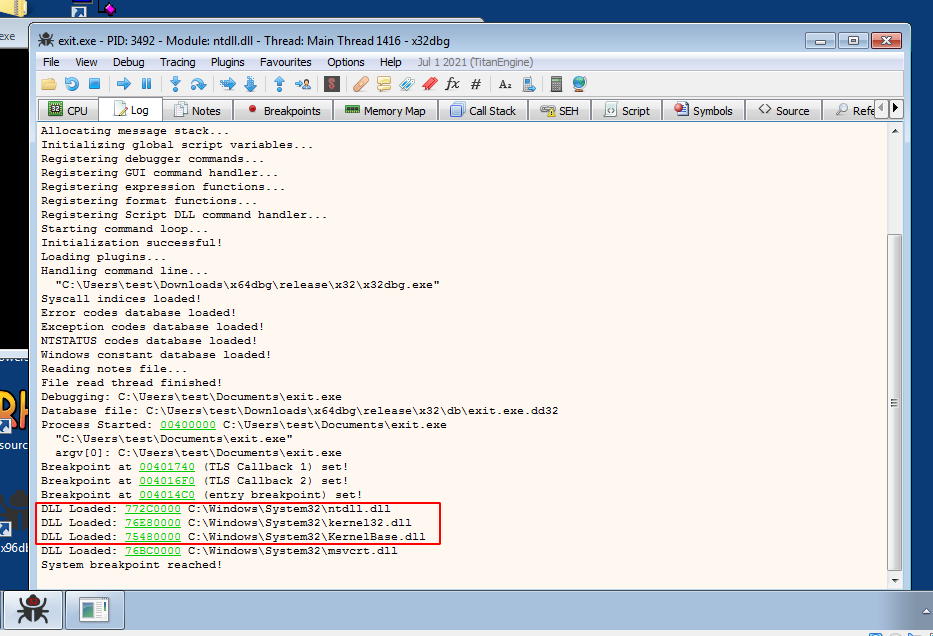
finding function’s addresses
So, we need to know the WinExec address in memory. We’ll find it!
/*
getaddr.c - get addresses of functions
(ExitProcess, WinExec) in memory
*/
#include <windows.h>
#include <stdio.h>
int main() {
unsigned long Kernel32Addr; // kernel32.dll address
unsigned long ExitProcessAddr; // ExitProcess address
unsigned long WinExecAddr; // WinExec address
Kernel32Addr = GetModuleHandle("kernel32.dll");
printf("KERNEL32 address in memory: 0x%08p\n", Kernel32Addr);
ExitProcessAddr = GetProcAddress(Kernel32Addr, "ExitProcess");
printf("ExitProcess address in memory is: 0x%08p\n", ExitProcessAddr);
WinExecAddr = GetProcAddress(Kernel32Addr, "WinExec");
printf("WinExec address in memory is: 0x%08p\n", WinExecAddr);
getchar();
return 0;
}
This program will tell you the kernel address and the WinExec address in kernel32.dll. Let’s compile it:
i686-w64-mingw32-gcc -O2 getaddr.c -o getaddr.exe -mconsole -I/usr/share/mingw-w64/include/ -s -ffunction-sections -fdata-sections -Wall -fno-exceptions -fmerge-all-constants -static-libstdc++ -static-libgcc >/dev/null 2>&1

and run in our target machine:
.\getaddr.exe
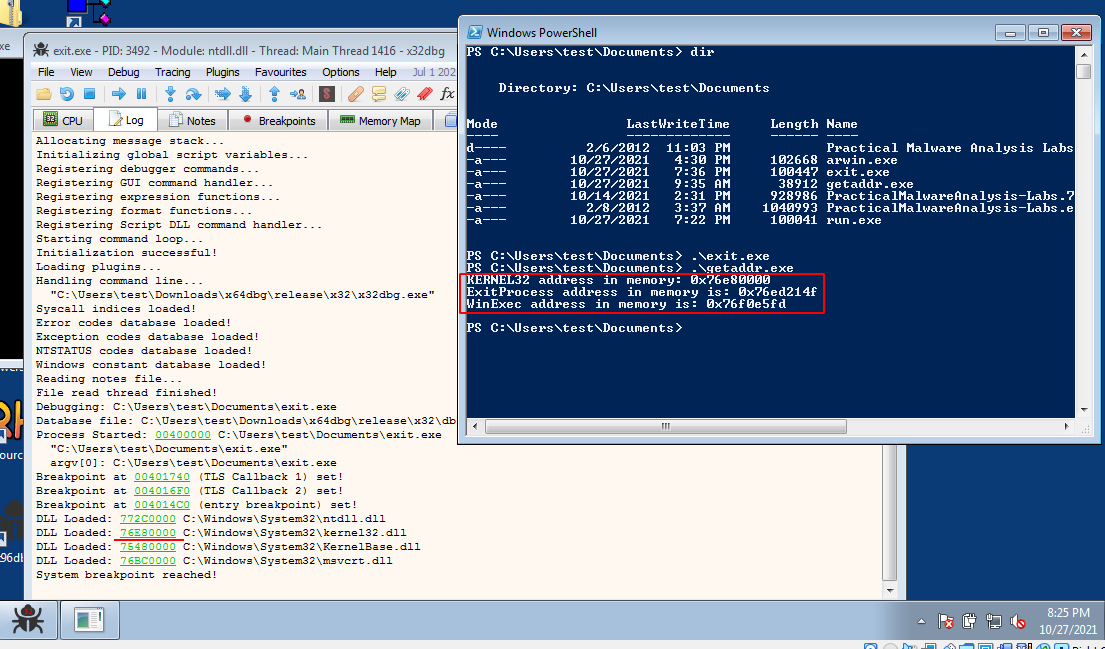
Now we know the addresses of our functions. Note that our program found the kernel32 address correctly.
assembly time
The WinExec() function within kernel32.dll can be used to launch any program that the user running the process can access:
UINT WinExec(LPCSTR lpCmdLine, UINT uCmdShow);
In our case, lpCmdLine is equal to calc.exe, uCmdShow is equal to 1 (SW_NORMAL).
Firstly convert calc.exe to hex via python script (conv.py):
# convert string to reversed hex
import sys
input = sys.argv[1]
chunks = [input[i:i+4] for i in range(0, len(input), 4)]
for chunk in chunks[::-1]:
print (chunk[::-1].encode("utf-8").hex())

Then, create our assembly code:
xor ecx, ecx ; zero out ecx
push ecx ; string terminator 0x00 for "calc.exe" string
push 0x6578652e ; exe. : 6578652e
push 0x636c6163 ; clac : 636c6163
mov eax, esp ; save pointer to "calc.exe" string in ebx
; UINT WinExec([in] LPCSTR lpCmdLine, [in] UINT uCmdShow);
inc ecx ; uCmdShow = 1
push ecx ; uCmdShow *ptr to stack in 2nd position - LIFO
push eax ; lpcmdLine *ptr to stack in 1st position
mov ebx, 0x76f0e5fd ; call WinExec() function addr in kernel32.dll
call ebx
To put something in Little Endian format, just put the hex of the bytes in as reverse
So, what about ExitProcess function?
void ExitProcess(UINT uExitCode);
It’s used to gracefully close the host process after the calc.exe process is launched using the WinExec function:
; void ExitProcess([in] UINT uExitCode);
xor eax, eax ; zero out eax
push eax ; push NULL
mov eax, 0x76ed214f ; call ExitProcess function addr in kernel32.dll
jmp eax ; execute the ExitProcess function
So, final code is:
; run calc.exe and normal exit
; author @cocomelonc
; nasm -f elf32 -o example1.o example1.asm
; ld -m elf_i386 -o example1 example1.o
; 32-bit linux (work in windows as shellcode)
section .data
section .bss
section .text
global _start ; must be declared for linker
_start:
xor ecx, ecx ; zero out ecx
push ecx ; string terminator 0x00 for "calc.exe" string
push 0x6578652e ; exe. : 6578652e
push 0x636c6163 ; clac : 636c6163
mov eax, esp ; save pointer to "calc.exe" string in ebx
; UINT WinExec([in] LPCSTR lpCmdLine, [in] UINT uCmdShow);
inc ecx ; uCmdShow = 1
push ecx ; uCmdShow *ptr to stack in 2nd position - LIFO
push eax ; lpcmdLine *ptr to stack in 1st position
mov ebx, 0x76f0e5fd ; call WinExec() function addr in kernel32.dll
call ebx
; void ExitProcess([in] UINT uExitCode);
xor eax, eax ; zero out eax
push eax ; push NULL
mov eax, 0x76ed214f ; call ExitProcess function addr in kernel32.dll
jmp eax ; execute the ExitProcess function
Compile:
nasm -f elf32 -o example1.o example1.asm
ld -m elf_i386 -o example1 example1.o
objdump -M intel -d example1

Then, let’s go to extract byte code via bash-hacking and objdump again:
objdump -M intel -d example1 | grep '[0-9a-f]:'|grep -v 'file'|cut -f2 -d:|cut -f1-6 -d' '|tr -s ' '|tr '\t' ' '|sed 's/ $//g'|sed 's/ /\\x/g'|paste -d '' -s |sed 's/^/"/'|sed 's/$/"/g'
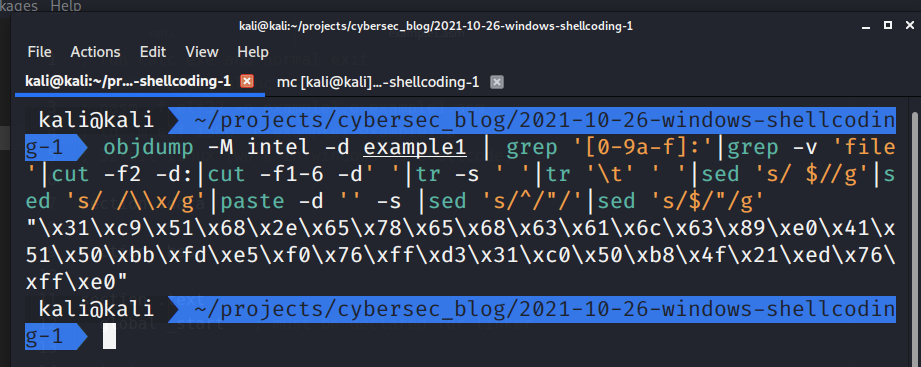
So, our bytecode is:
"\x31\xc9\x51\x68\x2e\x65\x78\x65\x68\x63\x61\x6c\x63\x89\xe0\x41\x51\x50\xbb\xfd\xe5\xf0\x76\xff\xd3\x31\xc0\x50\xb8\x4f\x21\xed\x76\xff\xe0"
compiled as ELF file for linux 32-bit because we are only using nasm to translate the opcodes for us
Then, replace the code at the top (run.c) with:
/*
run.c - a small skeleton program to run shellcode
*/
// bytecode here
char code[] = "\x31\xc9\x51\x68\x2e\x65\x78\x65\x68\x63\x61\x6c\x63\x89\xe0\x41\x51\x50\xbb\xfd\xe5\xf0\x76\xff\xd3\x31\xc0\x50\xb8\x4f\x21\xed\x76\xff\xe0";
int main(int argc, char **argv) {
int (*func)(); // function pointer
func = (int (*)()) code; // func points to our shellcode
(int)(*func)(); // execute a function code[]
// if our program returned 0 instead of 1,
// so our shellcode worked
return 1;
}
Compile:
i686-w64-mingw32-gcc run.c -o run.exe

And run:
.\run.exe
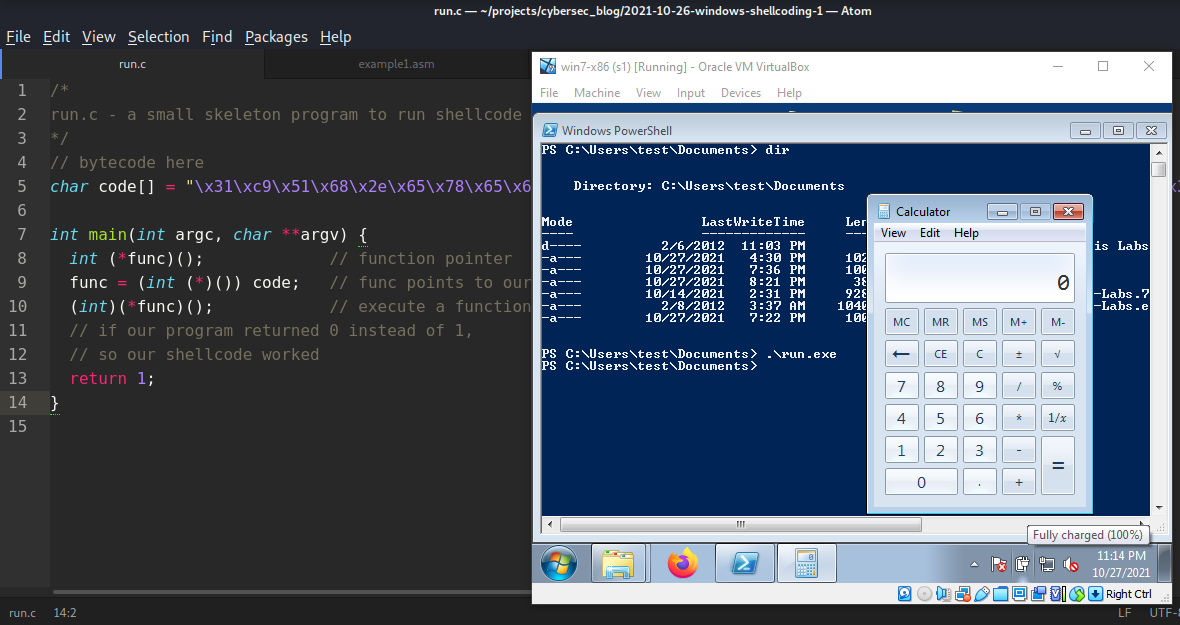
The
calc.exeprocess runs even after the host process dies because it is it’s own process.
So our shellcode is perfectly worked :)
This is how you create your own shellcode for windows, for example.
But, there is one caveat. This shellcode will only work on this machine. Because, the addresses of all DLLs and their functions change on reboot and are different on each system. In order for it to work on any windows 7 x86 sp1, ASM needs to find the addresses of the functions by itself. I will do this in the next part.
This is a practical case for educational purposes only.
WinExec
ExitProcess
The Shellcoder’s Handbook
my intro to x86 assembly
my nasm tutorial
linux shellcoding part 1
linux shellcoding part 2
Source code in Github
Thanks for your time, happy hacking and good bye!
PS. All drawings and screenshots are mine




